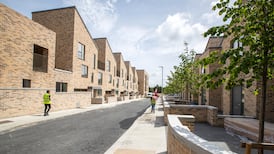A bridge to remember the 14 people who were shot dead at Croke Park on Bloody Sunday in 1920 has been renamed.
The bridge is the one familiar to GAA fans as they approach Croke Park down Russell Street towards the Hogan Park/Canal End entrances. It was formerly known as Clonliffe Bridge.
The proposal to rename the bridge was first made in 2020 for the centenary of Bloody Sunday. An online consultation showed a small majority of residents were against it, with Social Democrats Cllr Mary Callaghan describing it as “divisive”. Nevertheless, the bridge renaming was approved by the council’s commemorations and naming committee last December and by the full council on June.
On November 21st, 1920 British troops opened fire on spectators during the match between Dublin and Tipperary in Croke Park. The 14 civilians killed including three children and one player, the Tipperary captain Michael Hogan, after whom the Hogan Stand was named.
READ MORE
The attacks were in revenge for the killing of 14 suspected British agents that morning by Michael Collins’s The Squad. That evening three men, Peadar Clancy, Dick McKee and Conor Clune, died while in custody making Bloody Sunday the deadliest day of the War of Independence.
The unveiling was done by the Lord Mayor of Dublin Daithí de Róiste who described it as a morning “the people of Dublin have been waiting for a long time”. He pointed out that the bridge is situated near where Jerome O’Leary (10), the youngest and first victim on Bloody Sunday in Croke Park was shot while sitting on a wall at the Canal End.
[ Diarmaid Ferriter: Bloody Sunday 1920 changed British attitudes to IrelandOpens in new window ]
[ Bloody Sunday 1920: The IRA ‘got the wrong man’ when they shot my uncleOpens in new window ]
Earlier Cllr de Róiste unveiled a Dublin City Council commemorative plaque outside 69 Blessington Street to O’Leary.
Dublin City Council historian in residence Cormac Moore said Bloody Sunday 1920 transformed Croke Park to “not just a playing field but now a martyred ground”.
Eight of the 14 dead were left in unmarked graves until 2015 but people like Michael Foley, author of The Bloodied Field, and Cian Murphy in the GAA, in tandem with the families, started to mark each grave plot with a headstone.
A number of relatives of those who died on Bloody Sunday were there. Micheál Nelson’s uncle Joseph Traynor was shot twice in the back while trying to escape over the wall running along the back to the goal at the Canal End. He was just 20, a GAA player and IRA volunteer at the time. He cycled from Ballymount to the match.
Mr Nelson said it is always civilians who suffer the most in wartime as witnessed by the Israel-Hamas conflict at present. The conflict between 1916 and 1923 is a microcosm of the conflicts that are occurring today.
The significance of a bridge being called “Bloody Sunday” should not go unnoticed, he believed.
The former President of Ireland Mary McAleese spoke during her inaugural address about the metaphor of building bridges between people.
The concluded by stating the lessons of Bloody Sunday is that “suppression brings about aggression, violence begets more violence and two wrongs do not make a right”.












